|
|
|
Your search within this document for 'inland' resulted in 14 matching pages.
|
| 1 |
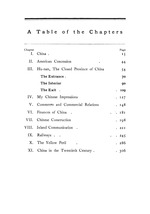 |
Page 9
“...A Table of the Chapte r s
Chapter I. China . Page 15
II. American Concession 44
III. Hu-nan, The Closed Province of China 54
The Entrance . 70
The Interior 90
The Exit 109
IV. My Chinese Impressions . 127
V. Commerce and Commercial Relations . 148
VI. Finances of China . 181
VII. Chinese Construction . 198
VIII. Inland Communication . . 221
IX. Railways . . 245
X. The Yellow Peril . 286
XI. China in the Twentieth Century . . 306...”
|
|
| 2 |
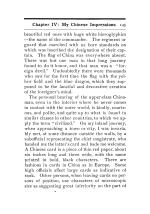 |
Page 145
“...for-
eign devil." Undoubtedly there were thousands
who saw for the first time the flag with the yel-
low field and the blue dragon, which they sup-
posed to be the fanciful and decorative creation
of the foreigner's mind.
The personal bearing of the upper-class China-
man, even in the interior where he never comes
in contact with the outer world, is kindly, courte-
ous, and polite, and quite up to what is found in
similar classes in other countries, to which we ap-
ply the term civilized." On my inland journey,
when approaching a town or city, I was invaria-
bly met, at some distance outside the walls, by a
subofficial representing the chief magistrate, who
handed me the latter's card and bade me welcome.
A Chinese card is a piece of thin red paper, about
six inches long and three wide, with the name
printed in bold, black characters. There are
fashions in cards in China as in Europe. Some
high officials affect large cards as indicative of
rank. Other persons, when leaving cards on per-
sons...”
|
|
| 3 |
 |
Page 192
“...American Engineer in China
tunities for helping friends in granting warrants
or in allowing their warrants to take precedence
over those of men less friendly are not neglected
by the Salt Commissioner, so that this position is
one much sought after, and when secured the
holder is considered on the way to wealth. Under
such circumstances, in China as elsewhere, it is
the people who finally pay all bills.
Next to the salt tax in importance is the likin
tax, levied, as was explained previously, on the
inland transportation of goods. None of these
likin stations keeps a record, so once more the
opportunity for stealing and waste is great.
In addition to the above, there is the revenue
received from the native custom-houses, from
special taxes on opium and miscellaneous sources.
The actual receipts of the Government under these
various headings can be taken approximately, as
follows:
Tls.
Land tax, in money.............25,000,000
" " grain.............. 7,000,000
Salt tax........................14...”
|
|
| 4 |
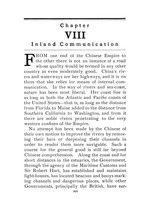 |
Page 221
“...Chapter
VIII
Inland Communication
FROM one end of the Chinese Empire to
the other there is not an instance of a road
whose quality would be termed in any other
country as even moderately good. China's riv-
ers and waterways are her highways, and it is on
them that she relies for means of internal com-
munication. In the way of rivers and sea-coast,
nature has been most liberal. Her coast line is
as long as both the Atlantic and Pacific coasts of
the United Statesthat is, as long as the distance
from Florida to Maine added to the distance from
Southern California to Washington, and from it
there are noble rivers penetrating to the very
western confines of the Empire.
No attempt has been made by the Chinese of
their own motion to improve the rivers by remov-
ing their bars or deepening their channels in
order to render them more navigable. Such a
course for the general good is still far beyond
Chinese comprehension. Along the coast and for
short distances in the estuaries, the Government...”
|
|
| 5 |
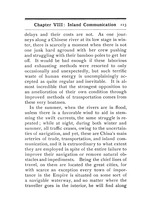 |
Page 223
“...Chapter VIII : Inland Communication 223
delays and their costs are not. As one jour-
neys along a Chinese river at its low stage in win-
ter, there is scarcely a moment when there is not
one junk hard aground with her crew pushing
and struggling with their bamboo poles to get her
off. It would be bad enough if these laborious
and exhausting methods were resorted to only
occasionally and unexpectedly, but such terrific
waste of human energy is uncomplainingly ac-
cepted as quite regular and inevitable. It is al-
most incredible that the strongest opposition to
an amelioration of their own condition through
improved methods of transportation comes from
these very boatmen.
In the summer, when the rivers are in flood,
unless there is a favorable wind to aid in stem-
ming the swift currents, the same struggle is re-
peated ; while at night, during both winter and
summer, all traffic ceases, owing to the uncertain-
ties of navigation, and yet, these are China's main
arteries of trade, transportation...”
|
|
| 6 |
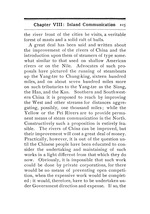 |
Page 225
“...Chapter VIII : Inland Communication 225
the river front of the cities he visits, a veritable
forest of masts and a solid raft of hulls.
A great deal has been said and written about
the improvement of the rivers of China and the
introduction upon them of steamers of type some-
what similar to that used on shallow American
rivers or on the Nile. Advocates of such pro-
posals have pictured the running of steamboats
up the Yang-tze to Chung-king, sixteen hundred
miles, and on about seven hundred miles more
on such tributaries to the Yang-tze as the Siang,
the Han, and the Kan. Southern and Southwest-
ern China it is proposed to reach by improving
the West and other streams for distances aggre-
gating, possibly, one thousand miles; while the
Yellow or the Pei Rivers are to provide perma-
nent means of steam communication in the North.
Constructively such a proposition is entirely fea-
sible. The rivers of China can be improved, but
their improvement will cost a great deal of money.
Practically...”
|
|
| 7 |
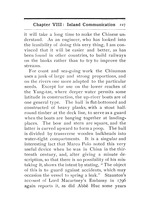 |
Page 227
“...Chapter VIII : Inland Communication 227
it will take a long time to make the Chinese un-
derstand. As an engineer, who has looked into
the feasibility of doing this very thing, I am con-
vinced that it will be easier and better, as has
been found in other countries, to build railways
on the banks rather than to try to improve the
streams.
For coast and sea-going work the Chinaman
uses a junk of large and strong proportions, and
011 the rivers one more adapted to the particular
needs. Except for use on the lower reaches of
the Yang-tze, where deeper water permits some
latitude in construction, the up-river boats are of
one general type. The hull is flat-bottomed and
constructed of heavy planks, with a stout half-
round timber at the deck line, to serve as a guard
when the boats are banging together at landing-
places. The bow and stern are square, and the
latter is curved upward to form a poop. The hull
is divided by transverse wooden bulkheads into
water-tight compartments. It is a singular...”
|
|
| 8 |
 |
Page 229
“...Chapter VIII : Inland Communication 229
later. The bulkhead was introduced in European
ship building in 1840 as a brilliant and new idea.
Thus it is that at almost every turn in this queer
land one meets with some device which we regard
with pride as a modern invention, but which the
Chinese have employed so long that its origin is
forgotten.
A deck load can be housed under curved
covers of bamboo matting resting on permanent
frames. Under these covers the crew of five men
or more also find quarters, while the owner and
his family reside in the stern. There are one or
two masts, according to the size of the boat, stand-
ing without stays and carrying large sails of
cotton canvas or light bamboo mats. Of boats
of this description there are tens of thousands,
and they pass and repass in endless processions.
Usually the boat itself is kept in fair condition,
but the same cannot be said of the sails. A new
sail is scarcely ever seen, and many of them are
so dilapidated as to cause wonder at...”
|
|
| 9 |
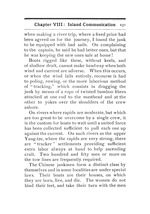 |
Page 231
“...Chapter VIII : Inland Communication 231
when making a river trip, where a fixed price had
been agreed on for the journey, I found the junk
to be equipped with bad sails. On complaining
to the captain, he said he had better ones, but that
he was keeping the new ones safe at home!
Boats rigged like these, without keels, and
of shallow draft, cannot make headway when both
wind and current are adverse. When this occurs,
or when the wind fails entirely, recourse is had
to poling, rowing, or the more laborious method
of tracking," which consists in dragging the
junk by means of a rope of twisted bamboo fibres
attached at one end to the masthead and at the
other to yokes over the shoulders of the crew
ashore.
On rivers where rapids are moderate, but which
are too great to be overcome by a single crew, it
is the custom for boats to wait until a united force
has been collected sufficient to pull each one up
against the current. On such rivers as the upper
Yang-tze, where the rapids are very strong...”
|
|
| 10 |
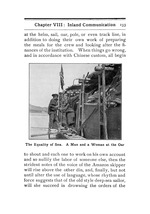 |
Page 233
“...Chapter VIII : Inland Communication 233
at the helm, sail, oar, pole, or even track line, in
addition to doing their own work of preparing
the meals for the crew and looking after the fi-
nances of the institution. When things go wrong,
and in accordance with Chinese custom, all begin
The Equality of Sex. A Man and a Woman at the Oar
to shout and each one to work on his own account
and so nullify the labor of someone else, then the
strident notes of the voice of the Amazon skipper
will rise above the other din, and, finally, but not
until after the use of language, whose rhythm and
force suggests that of the old style deep-sea sailor,
will she succeed in drowning the orders of the...”
|
|
| 11 |
 |
Page 237
“...Chapter VIII : Inland Communication 237
on the axle, and on both sides of the wheel like an
Irish jaunting car. In some cities, like Shanghai,
these wheelbarrows are for hire like cabs by the
natives, and as little or no load comes on the
wheelman, it is not an infrequent sight to see him
pushing four fares at a speed of four or five miles
an hour.
Fast Freight by Wheelbarrow
In the up-country ol the Yang-tze Valley such
wheelbarrows are the great means of fast freight
transportation. On them the farmer will take his
supply of produce to market, or if he has to take
his wife along, for she with her small feet cannot
walk, he will usually place her on one side and
possibly a dead hog that he has slaughtered that
morning on the other side in order to balance her
weight....”
|
|
| 12 |
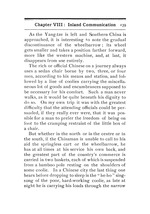 |
Page 239
“...Chapter VIII : Inland Communication 239
As the Yang-tze is left and Southern China is
approached, it is interesting to note the gradual
discontinuance of the wheelbarrow ; its wheel
gets smaller and takes a position farther forward,
more like the western machine, and, at last, it
disappears from use entirely.
The rich or official Chinese on a journey always
uses a sedan chair borne by two, three, or four
men, according to his means and station, and fol-
lowed by a line of coolies carrying the miscella-
neous lot of goods and encumbrances supposed to
be necessary for his comfort. Such a man never
walks, as it would be quite beneath his dignity to
do so. On my own trip it was with the greatest
difficulty that the attending officials could be per-
suaded, if they really ever were, that it was pos-
sible for a man to prefer the freedom of being on
foot to the cramping restraint of the little box of
a chair.
But whether in the north or in the centre or in
the south, if the Chinaman is unable...”
|
|
| 13 |
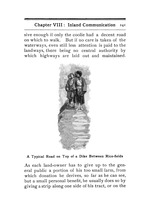 |
Page 241
“...Chapter VIII : Inland Communication 241
sive enough if only the coolie had a decent road
on which to walk. But if no care is taken of the
waterways, even still less attention is paid to the
landways, there being no central authority by
which highways are laid out and maintained.
A Typical Road on Top of a Dike Between Rice-fields
As each land-owner has to give up to the gen-
eral public a portion of his too small farm, from
which donation he derives, so far as he can see,
but a small personal benefit, he usually does so by
giving a strip along one side of his tract, or on the...”
|
|
| 14 |
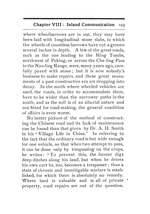 |
Page 243
“...Chapter VIII : Inland Communication 243
where wheelbarrows are in use, they may have
been laid with longitudinal stone slabs, in which
the wheels of countless barrows have cut a groove
several inches in depth. A few of the great roads,
such as the one leading to the Ming Tombs,
northwest of Peking, or across the Che-ling Pass
iirthe Nan-ling Range, were, many years ago, care-
fully paved with stone ; but it is now nobody's
business to make repairs, and these great monu-
ments of a past constructive era are dropping into
decay. In the north where wheeled vehicles are
used, the roads, in order to accommodate them,
have to be wider than the narrower paths in the
south, and as the soil is of an alluvial nature and
not fitted for road-making, the general condition
of affairs is even worse.
No better picture of the method of construct-
ing the Chinese road and its lack of maintenance
can be found than that given by Dr. A. H. Smith
in his Village Life in China." In referring to
the fact that the...”
|
|
|